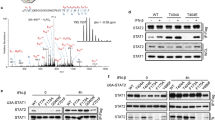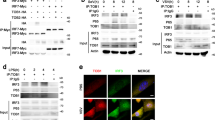Abstract
Interferon-γ (IFN-γ) is a pleiotropic cytokine involved in antiproliferative and anti-virus responses, immune surveillance and tumor suppression. These biological responses to IFN-γ are mainly mediated by the regulation of gene expression. It has been reported that growth-inhibitory role of IFN-γ is dependent on activation of signal transducers and activators of transcription 1 (STAT1); however, the molecular basis downstream of STAT1 remains unclear. Here, we report that an IFN-γ-induced gene, interferon-induced transmembrane protein 1 (IFITM1), plays a key role in the antiproliferative action of IFN-γ. Overexpression of IFITM1 negatively regulated cell growth, whereas suppression of IFITM1 blocked the antiproliferative effect of IFN-γ, accelerated the cell growth rate and conferred tumorigenicity to a non-malignant hepatocyte in nude mice. Further, IFITM1 could inhibit the activity of extracellular signal-regulated kinase, enhance the transcriptional activity of p53 and stabilize the p53 protein by inhibiting p53 phosphorylation on Thr55. Suppression of p53 reduced the growth-inhibitory capacity of both IFITM1 and IFN-γ. Therefore, these findings indicated that the antiproliferative action of IFN-γ requires the induction of IFITM1, and provided a crosstalk between two well-known signaling mediators, STAT1 and p53, both of which play critical roles in tumor suppression.
This is a preview of subscription content, access via your institution
Access options
Subscribe to this journal
Receive 50 print issues and online access
$259.00 per year
only $5.18 per issue
Buy this article
- Purchase on Springer Link
- Instant access to full article PDF
Prices may be subject to local taxes which are calculated during checkout







Similar content being viewed by others
References
Abba MC, Drake JA, Hawkins KA, Hu Y, Sun H, Notcovich C et al. (2004). Breast Cancer Res 6: R499–R513.
Ackrill AM, Reid LE, Gilbert CS, Gewert DR, Porter AC, Lewin AR et al. (1991). Nucleic Acids Res 19: 591–598.
Akyerli CB, Beksac M, Holko M, Frevel M, Dalva K, Ozbek U et al. (2005). Leukemia Res 29: 283–286.
Alber D, Staeheli P . (1996). J Interferon Cytokine Res 16: 375–380.
Bradbury LE, Kansas GS, Levy S, Evans RL, Tedder TF . (1992). J Immunol 149: 2841–2850.
Bromberg JF, Horvath CM, Wen Z, Schreiber RD, Darnell Jr JE . (1996). Proc Natl Acad Sci USA 93: 7673–7678.
Brummelkamp TR, Bernards R, Agami R . (2002). Science 296: 550–553.
Buard A, Vivo C, Monnet I, Boutin C, Pilatte Y, Jaurand MC . (1998). Cancer Res 58: 840–847.
Catchpoole D, Lam WW, Valler D, Temple IK, Joyce JA, Reik W et al. (1997). J Med Genet 34: 353–359.
Chen YX, Welte K, Gebhard DH, Evans RL . (1984). J Immunol 133: 2496–2501.
Cheng M, Wang D, Roussel MF . (1999). J Biol Chem 274: 6553–6558.
Chin YE, Kitagawa M, Su WC, You ZH, Iwamoto Y, Fu XY . (1996). Science 272: 719–722.
Darnell Jr JE, Kerr IM, Stark GR . (1994). Science 264: 1415–1421.
Deblandre GA, Marinx OP, Evans SS, Majjaj S, Leo O, Caput D et al. (1995). J Biol Chem 270: 23860–23866.
Dighe AS, Richards E, Old LJ, Schreiber RD . (1994). Immunity 1: 447–456.
Diller L, Kassel J, Nelson CE, Gryka MA, Litwak G, Gebhardt M et al. (1990). Mol Cell Biol 10: 5772–5781.
el-Deiry WS, Tokino T, Velculescu VE, Levy DB, Parsons R, Trent JM et al. (1993). Cell 75: 817–825.
Evans SS, Lee DB, Han T, Tomasi TB, Evans RL . (1990). Blood 76: 2583–2593.
Friedman RL, Manly SP, McMahon M, Kerr IM, Stark GR . (1984). Cell 38: 745–755.
Galbiati F, Volonte D, Engelman JA, Watanabe G, Burk R, Pestell RG et al. (1998). EMBO J 17: 6633–6648.
Galbiati F, Volonte D, Liu J, Capozza F, Frank PG, Zhu L et al. (2001). Mol Biol Cell 12: 2229–2244.
Halaschek-Wiener J, Wacheck V, Kloog Y, Jansen B . (2004). Cell Signal 16: 1319–1327.
Huang H, Colella S, Kurrer M, Yonekawa Y, Kleihues P, Ohgaki H . (2000). Cancer Res 60: 6868–6874.
Huang R, Wu T, Xu L, Liu A, Ji Y, Hu G . (2002). FASEB J 16: 293–301.
Kano A, Haruyama T, Akaike T, Watanabe Y . (1999). Biochem Biophys Res Commun 257: 672–677.
Kaplan DH, Shankaran V, Dighe AS, Stockert E, Aguet M, Old LJ et al. (1998). Proc Natl Acad Sci USA 95: 7556–7561.
Karnik P, Paris M, Williams BR, Casey G, Crowe J, Chen P . (1998). Hum Mol Genet 7: 895–903.
Kelly JM, Gilbert CS, Stark GR, Kerr IM . (1985). Eur J Biochem 153: 367–371.
Kominsky SL, Hobeika AC, Lake FA, Torres BA, Johnson HM . (2000). Cancer Res 60: 3904–3908.
Levine AJ . (1997). Cell 88: 323–331.
Li HH, Li AG, Sheppard HM, Liu X . (2004). Mol Cell 13: 867–878.
Liu MK, Brownsey RW, Reiner NE . (1994). Infect Immun 62: 2722–2731.
Lu KH, Weitzel JN, Kodali S, Welch WR, Berkowitz RS, Mok SC . (1997). Cancer Res 57: 387–390.
Maier JA, Morelli D, Balsari A . (1995). Biochem Biophys Res Commun 214: 582–588.
Mandal M, Bandyopadhyay D, Goepfert TM, Kumar R . (1998). Oncogene 16: 217–225.
Marshall C . (1999). Curr Opin Cell Biol 11: 732–736.
Matsumoto AK, Martin DR, Carter RH, Klickstein LB, Ahearn JM, Fearon DT . (1993). J Exp Med 178: 1407–1417.
Matsushita K, Takenouchi T, Shimada H, Tomonaga T, Hayashi H, Shioya A et al. (2006). Cancer Sci 97: 57–63.
McCarthy SA, Chen D, Yang BS, Garcia Ramirez JJ, Cherwinski H, Chen XR et al. (1997). Mol Cell Biol 17: 2401–2412.
Muller M, Laxton C, Briscoe J, Schindler C, Improta T, Darnell Jr JE et al. (1993). EMBO J 12: 4221–4228.
Negrini M, Rasio D, Hampton GM, Sabbioni S, Rattan S, Carter SL et al. (1995). Cancer Res 55: 3003–3007.
Nguyen DT, Kebache S, Fazel A, Wong HN, Jenna S, Emadali A et al. (2004). Mol Biol Cell 15: 4248–4260.
Notari M, Neviani P, Santhanam R, Blaser BW, Chang JS, Galietta A et al. (2006). Blood 107: 2507–2516.
O'Briant KC, Bepler G . (1997). Genes Chromosomes Cancer 18: 111–114.
Pages G, Lenormand P, L'Allemain G, Chambard JC, Meloche S, Pouyssegur J . (1993). Proc Natl Acad Sci USA 90: 8319–8323.
Reid LE, Brasnett AH, Gilbert CS, Porter AC, Gewert DR, Stark GR et al. (1989). Proc Natl Acad Sci USA 86: 840–844.
Ries S, Biederer C, Woods D, Shifman O, Shirasawa S, Sasazuki T et al. (2000). Cell 103: 321–330.
Rodig S, Kaplan D, Shankaran V, Old L, Schreiber RD . (1998). Eur Cytokine Network 9: 49–53.
Roussel MF, Davis JN, Cleveland JL, Ghysdael J, Hiebert SW . (1994). Oncogene 9: 405–415.
Sakatsume M, Stancato LF, David M, Silvennoinen O, Saharinen P, Pierce J et al. (1998). J Biol Chem 273: 3021–3026.
Scheffner M, Werness BA, Huibregtse JM, Levine AJ, Howley PM . (1990). Cell 63: 1129–1136.
Schlegel A, Arvan P, Lisanti MP . (2001). J Biol Chem 276: 4398–4408.
Seliger B, Pfizenmaier K, Schafer R . (1991). J Virol 65: 6307–6311.
Stancato LF, Yu CR, Petricoin III EF, Larner AC . (1998). J Biol Chem 273: 18701–18704.
Stark GR, Kerr IM, Williams BR, Silverman RH, Schreiber RD . (1998). Annu Rev Biochem 67: 227–264.
Takahashi S, Doss C, Levy S, Levy R . (1990). J Immunol 145: 2207–2213.
Tran YK, Newsham IF . (1996). Cancer Res 56: 2916–2921.
Yang BS, Hauser CA, Henkel G, Colman MS, Van BC, Stacey KJ et al. (1996). Mol Cell Biol 16: 538–547.
Yeh PY, Chuang SE, Yeh KH, Song YC, Chang LL, Cheng AL . (2004). Oncogene 23: 3580–3588.
Yeh PY, Chuang SE, Yeh KH, Song YC, Cheng AL . (2001). Biochem Biophys Res Commun 284: 880–886.
Zauberman A, Flusberg D, Haupt Y, Barak Y, Oren M . (1995). Nucleic Acids Res 23: 2584–2592.
Acknowledgements
We thank Dr B Vogelstein (Johns Hopkins University, Baltimore, MD, USA) for p53 reporter plasmid, Dr Xin Wu (Liver Cancer Institute, Zhongshan Hospital, Medical Center of Fudan University, Shanghai) for clinical HCC samples, and Chaochen Wang and Zheng Qin for technical assistances. This work was support by Chinese High-Tech R&D Program (863)-2001AA231011 and-20022Z2002.
Author information
Authors and Affiliations
Corresponding author
Additional information
Supplementary Information accompanies the paper on the Oncogene website (http://www.nature.com/onc).
Supplementary information
Rights and permissions
About this article
Cite this article
Yang, G., Xu, Y., Chen, X. et al. IFITM1 plays an essential role in the antiproliferative action of interferon-γ. Oncogene 26, 594–603 (2007). https://doi.org/10.1038/sj.onc.1209807
Received:
Revised:
Accepted:
Published:
Issue Date:
DOI: https://doi.org/10.1038/sj.onc.1209807
Keywords
This article is cited by
-
Pharmacological inhibition of METTL3 impacts specific haematopoietic lineages
Leukemia (2023)
-
CircVPS13C promotes pituitary adenoma growth by decreasing the stability of IFITM1 mRNA via interacting with RRBP1
Oncogene (2022)
-
Epigenetic regulation of IFITM1 expression in lipopolysaccharide-stimulated human mesenchymal stromal cells
Stem Cell Research & Therapy (2020)
-
Down-regulation of IFITM1 and its growth inhibitory role in cervical squamous cell carcinoma
Cancer Cell International (2017)
-
Expression of IFITM1 as a prognostic biomarker in resected gastric and esophageal adenocarcinoma
Biomarker Research (2016)



